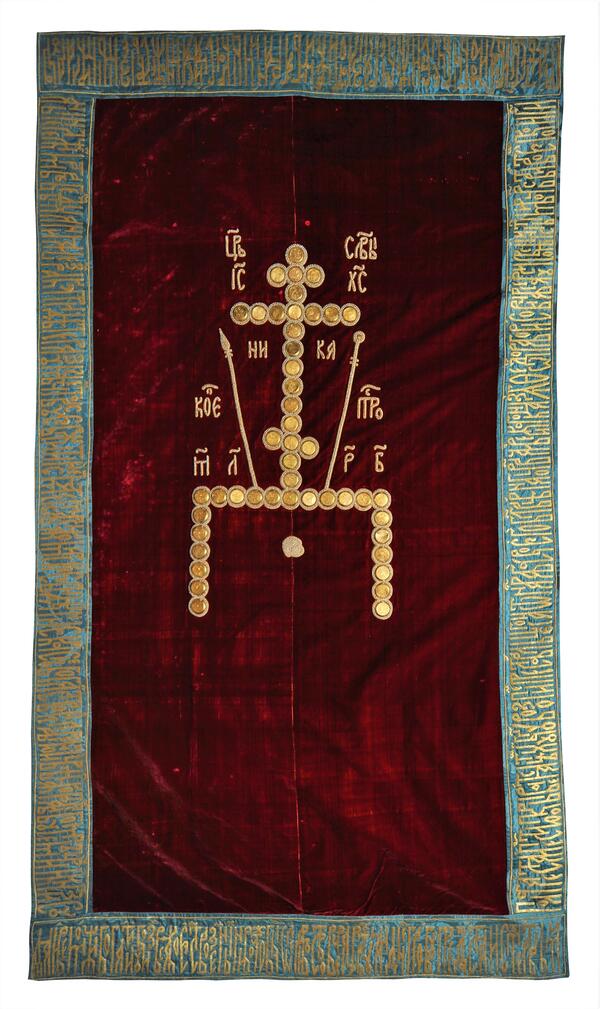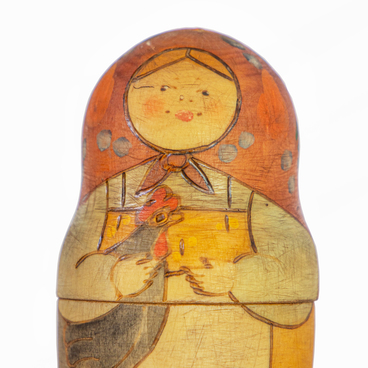The Pall for the tomb of Tsar Fyodor Godunov was created for special obits. Such obits were performed on the days of remembrance of the Godunov family. The burial vault of the tsar’s dynasty in the Trinity-St. Sergius Monastery has existed since 1606.
Its appearance was preceded by dramatic circumstances. On April 13, 1605, during the struggle with the impostor False Dmitry I, Tsar Boris Godunov died suddenly. His son Fyodor ascended to the throne. But the army betrayed the young tsar and defected to the side of the impostor. By the order of False Dmitry I, Fyodor Godunov and his mother Maria Grigoryevna were killed, and their bodies were thrown into a “skudelnitsa” (mass grave) in the Varsonofiev Monastery in Moscow. There, the remains of Boris Godunov were thrown into a common grave after a three-day “desecration”. They had previously been removed from his tomb in the Archangel Cathedral.
However, the False Dmitry was also soon killed. The new Tsar Vasiliy Shuisky ordered Boris Godunov and his family to be reburied in the Trinity-St. Sergius Monastery. The Godunovs were buried in the western porch of the Assumption Cathedral, and in 1622, next to their father, mother and brother, the Princess Ksenia Godunova, who took monastic vows with the name Olga, was also buried.
The tombstones in the church were decorated in a special way to emphasize the area of the Borisov family mortuary chapel. Candlesticks were placed in front of the tombstones, icons in precious frames were placed in several rows on the walls around the graves. On the tombstones, palls were laid, which were of two types — festive ones made of black and red (“chervchaty”) velvet and everyday ones made of black and red-purple cloth. Red-colored covers were laid during memorial and festive services.
In 1780-1781, the western porch of the Assumption Cathedral was dismantled and a vault was built over the graves of Tsar Boris and his relatives, which has survived to our time. From that moment on, the memorable days of Tsar Boris' family in the Lavra were no longer celebrated with special church services.
By this time, the three festive palls kept in the monastery sacristy (a special place for liturgical vestments) had become dilapidated and pearls and other ornaments were cut off from them. Only the pall on the tomb of Tsar Fyodor Godunov, sewn from red velvet with silver inserts-decorative plaques, pearls and gold embroidery, has been preserved. 46 decorative plaques with engraved images of saints form the Golgotha Cross in the center of the cloth. Perhaps the sister of Tsar Fyodor, Ksenia (Olga), who also created other works of pictorial embroidery, took part in the creation of this pall.
Its appearance was preceded by dramatic circumstances. On April 13, 1605, during the struggle with the impostor False Dmitry I, Tsar Boris Godunov died suddenly. His son Fyodor ascended to the throne. But the army betrayed the young tsar and defected to the side of the impostor. By the order of False Dmitry I, Fyodor Godunov and his mother Maria Grigoryevna were killed, and their bodies were thrown into a “skudelnitsa” (mass grave) in the Varsonofiev Monastery in Moscow. There, the remains of Boris Godunov were thrown into a common grave after a three-day “desecration”. They had previously been removed from his tomb in the Archangel Cathedral.
However, the False Dmitry was also soon killed. The new Tsar Vasiliy Shuisky ordered Boris Godunov and his family to be reburied in the Trinity-St. Sergius Monastery. The Godunovs were buried in the western porch of the Assumption Cathedral, and in 1622, next to their father, mother and brother, the Princess Ksenia Godunova, who took monastic vows with the name Olga, was also buried.
The tombstones in the church were decorated in a special way to emphasize the area of the Borisov family mortuary chapel. Candlesticks were placed in front of the tombstones, icons in precious frames were placed in several rows on the walls around the graves. On the tombstones, palls were laid, which were of two types — festive ones made of black and red (“chervchaty”) velvet and everyday ones made of black and red-purple cloth. Red-colored covers were laid during memorial and festive services.
In 1780-1781, the western porch of the Assumption Cathedral was dismantled and a vault was built over the graves of Tsar Boris and his relatives, which has survived to our time. From that moment on, the memorable days of Tsar Boris' family in the Lavra were no longer celebrated with special church services.
By this time, the three festive palls kept in the monastery sacristy (a special place for liturgical vestments) had become dilapidated and pearls and other ornaments were cut off from them. Only the pall on the tomb of Tsar Fyodor Godunov, sewn from red velvet with silver inserts-decorative plaques, pearls and gold embroidery, has been preserved. 46 decorative plaques with engraved images of saints form the Golgotha Cross in the center of the cloth. Perhaps the sister of Tsar Fyodor, Ksenia (Olga), who also created other works of pictorial embroidery, took part in the creation of this pall.



